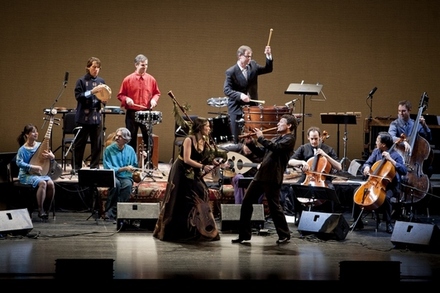 The Silk Road Ensemble. Yo-Yo Ma is second from the right.
The Silk Road Ensemble. Yo-Yo Ma is second from the right. The first event, on September 13, was the world premiere of the film The Music of Strangers. The documentary about Ma’s Silk Road Ensemble was presented by the Toronto International Film Festival at the Elgin Theatre. And the second event, two days later, was a live performance by Silk Road at Massey Hall.
Curiously, the film offers almost no explanation of the name Ma selected for his band. Somehow, viewers are just supposed to know that the Silk Road was an ancient trade route that connected the Mediterranean world with the Far East. The musicians Ma chose are all from countries along the route – and the underlying implication is that, through centuries of contact, traditional musicians living today in Europe and Asia share common artistic ground.
What the film does do is offer in-depth looks at five of the members of Silk Road: pipa-player Wu Man from China, clarinetist Kinan Azmeh from Syria, bagpipe-player Cristina Pato from Spain, kamancheh-player Kayhan Kalhor from Iran, and of course Ma himself.
In its format, The Music of Strangers reminded me of the 1999 film Buena Vista Social Club (about Cuban jazz): musicians are featured one at a time, talking about their lives, their music and their world-views. To accomplish this, Neville followed these musicians to their various homelands, which added a vivid sense of local colour to the movie. And, in the case of Azmeh from Syria and Kalhor from Iran, the on-site locations bring viewers face to face with war and oppression.
The Music of Strangers is a rambling film: sometimes a scene with a musician ends in what feels like a satisfyingly conclusive way – only for the same musician to pop up again 15 minutes later with more to say. But one of the strengths of the film is that there’s lots of music. And that’s what the Silk Road Ensemble is all about.
The Massey Hall concert brought to the stage the five musicians featured in the film, plus ten others.
Together, these musicians from far and wide were a remarkably cohesive ensemble. I don’t know how they dealt with tuning issues, but they managed to sound like they were meant to play together – and that was no mean feat. (They were also heavily amplified, which was something I could have done without. But I guess that’s what all the kids want these days.)
It was an evening of musical revelations, and for me the biggest revelation was Pato. This green-haired Galician has been described as a “force of nature.” To be sure, much of that force comes from her instrument, a strident little bagpipe that cuts through the band like razor-sharp knife. But she also has a musical energy all her own, brilliantly displayed in a folk-music medley (by Edward Perez) called the Latina 6/8 Suite.
Matching her intensity was the vocal artistry of Aynur Dogan. She sang Layers of Loneliness by Kalhor, based on Kurdish folk songs. Aynur – she goes by her first name only – has a voice like a blowtorch, focused and searing. But she can also vocalize in dark, guttural ways that reminded me of Tanya Tagaq. (Has Aynur been listening to Inuit throat singing?)
Also impressive was Azmeh. Although he plays a Western clarinet, in his hands it becomes an Arabic instrument. As well, he can play like a wild and crazy klezmer musician, bending notes into pretzels – or imitate the soft, veiled tone of an Armenian duduk.
Kalhor’s kamancheh sang in beautifully plangent tones, and Kojiro Umezaki played his shakuhachi with breathy intensity. Tabla player Sandeep Das was a supportive presence throughout most of the concert – and it was a pleasure to hear him as a soloist in a virtuosic piece called Punjabi Gharana.
It surely would have also been a pleasure to hear Wu and her pipa more prominently featured. However, the most conspicuously under-presented musician on stage was Ma, who rarely took a soloistic role. This was a disappointment: he is, after all, the world’s foremost cellist.
I recall that much the same thing happened the last time the Silk Road Ensemble appeared in Toronto: Ma was seen but not heard very often. I pointed this problem out at the time, in a review, encouraging the cellist to step forward and show the audience what he can do. Evidently, he declined to take my advice. From now on, he’ll have to get by without my helpful words of wisdom.
© Colin Eatock 2015
 RSS Feed
RSS Feed

